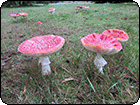 photo by splunge
photo by splunge
 photo by TheophileEscargot
photo by TheophileEscargot
 photo by Kronos_to_Earth
photo by Kronos_to_Earth
 photo by ethylene
photo by ethylene
Comment Feed:
♦ RSS
While many fruit "prefer" to be eaten by birds (or fruit bats) - (since these represent some of the best long- distance transportation vectors). Some fruit actively discourage being eaten by creatures such as large mammals - using toxins. However some fruit also do not seem to mind being eaten by large mammals.
Among these are a number of tropical fruit - bananas, rambutan, mangoes, papaya, pomegranates, organges and guava.
However many of these fruit face a difficult problem - how to make themselves attractive to animals without also becoming the prey of all manner of insects (who do not represent a very attractive vector for their seeds).
Some take to poisons - strong enough to deter insects, but easily dealt with by the liver of a large animal.
Others have taken to using a protective barrier - thick enough to discourage insects - but removed easily enough removed by a sufficiently large creature.
Bananas, oranges, rambutan, mangoes, pomegranates, jackfruit and breadfruit have adopted the "barrier" solution - with some success.
However none of them have taken the approach of using a physical barrier to the same heights that the durian has.
The durian doesn't just have a skin: its flesh and seeds are secured inside a well-defended fortress. Durian rind is not just impenetrable to insects - the innumerable sharp spikes also represent a defense against the beaks of birds, rodents - and all manner of small creatures.
However the durian's rind is self-opening - when the durian is ripe it cracks along internal fault lines, and starts to open by itself.
The rock and pool,
is nice and cool,
so juicy sweet.
Our only wish,
to catch a fish,
so juicy sweet!
You have to wait until the tissue comes out of rigor mortis?
*roots for the octopus*
posted by mudpuppie 15 January | 17:29